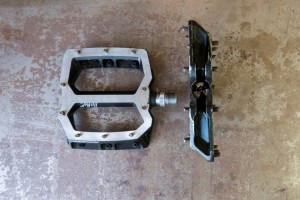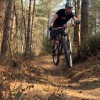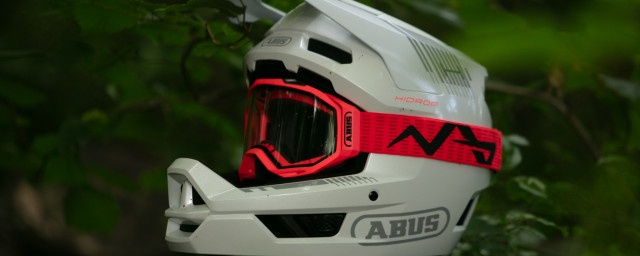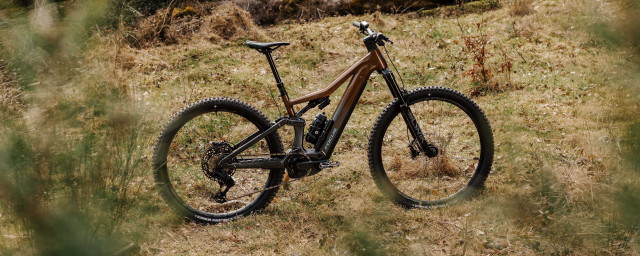The PINND CS2 is a beautifully made and finished flat pedal that comes with high-level bearings, materials, and nice looks. They need improvement to their shape and function to be worthy of standing out from the competition, especially given the very high price point. Although they offer very good grip, their tall height means there have been cases of clipping trail features. I also found my foot rocked over the front at times.
- Maxxis Shorty Gen 2 tyre review
- The best mountain bike flat pedals ridden and tested
- 5 cool things from Fist Handwear, Muc-Off, Shimano, Scott and Bontrager
PINND CS2 Flat Pedal review - Technical details
Built on a Grade 5 Titanium spindle, the 7075 T6 Aluminium is machined and finished to create the 110 x105mm platform. The spindle sits on 2 cartridge bearings on the outer and an HK1015 Needle Bearing on the inner. These pedals are certainly constructed from top-grade materials.
There is the option to run 13 pins per side on the pedal body, giving 26 per pedal. I ran a row of three on the leading edge and four on the back, with two on the outer edge. There is also the option for four more pins in the centre of the pedal, but I found these lessened the grip and the concave effect of the body.
The pins are fully replaceable and made from 303 Stainless Steel and can be removed with a small spanner or mole grips if you batter them. They are 5mm tall and 3mm wide, which suggests they should offer a huge amount of grip. The pedal body is also machined with a waved texture to add additional grip.
The pedal body is noticeably tall - nearly 22mm on the outer edge. They adopt an offset parallelogram shape, with an angled leading edge to deflect or slide off strikes. Talking to PINND, they say, 'The offset platform is there to allow the leading edge to be angled to deflect anything that you hit with the pedal. Without the offset platform, you would be left with a square edge, and this would catch rather than deflect.'
The inside height is approximately 18mm at the pedal spindle, allowing space for large and potentially more durable bearings. Part of the increased height of the pedal is down to this large spindle size. PINND say, 'We felt that the performance and longevity of the bearing would outweigh the compromise on a couple of millimetres on the thickness.'
PINND also offers a five-year warranty with the pedal, although that doesn't cover normal wear and tear.
PINND CS2 Flat Pedal review - out on the trail
Despite the purposeful looks, excellent finish and (mostly) well-thought-out design, I was disappointed with the CS2. My issue is the height of the pedal platform, which is nearly 4mm taller than my usual pedal of choice, the Deity TMac; far from being the thinnest pedal around but still has a relatively low profile.
There is no denying that there is decent and reasonable foot grip on smooth flowing trails in all weathers, but I didn't feel the CS2 offered a 'locked in' ride feel. The pins are pretty bulky, and I felt at times when my foot wasn't engaged properly.
The large pins are supposed to offer aggressive grip but are perhaps overkill as bigger is not always better if your shoes don't gel with them. I tested them with two pairs of FiveTens (old and new) and a pair of Giro with Vibram soles. Unsurprisingly the FiveTens were loads better, and the Giro with a firmer sole skated over the pins, and the grip wasn't anywhere near as good. I would rather see smaller, narrower pins balanced with a deeper central drop to increase the concave shape. I noticed more instances of getting clawed into the back of my leg with them than other pedals, and ouch - they bite!
But, and this is a deal-breaker for me, on any trail with rough surfaces - think natural trails, with exposed roots and rocks, I found myself clouting things with the pedals a lot more than any other pedal I've ridden. Not just up or traversing when pedalling, but also downhill when cranks were level - one particular trail had me cursing as I clipped where normally I met little or no issue.
The problem is the height on the outer front edge - it's just a big slab of metal waiting to smack something. While other pedals have a thinner profile that places the foot lower, the CS2 pedals are reasonably thick.
I feel that the added height of the pedal, with the thick leading edge, makes for a pedal that's more prone to pedal strikes and whilst the build is strong, it feels outdated and overly chunky. Yes, it is angled to deflect off the leading edge, but it's still a flat face as opposed to a rounded shape, whereas other pedals like the DMR V11 are slightly thinner more rounded, which means they slide or don't strike as much.
Another issue is that the pedals are longer from the axle to the front edge and fairly short from the axle to the rear. While this kind of parallelogram shape isn't unusual, in this case, it's rather extreme and ends up acting as a lever, with a bias to weight over the front - not ideal when you want to be riding downhill with dropped heels as it can sometimes unbalance and force weight on the pedal, over the front of its axle.
It's more noticeable when traversing trails or uphill when on flats as you have little to no traction on the upstroke, and I found myself having to make a conscious effort to keep my toes and front of the foot on the pedal as it wanted to tip forward or roll-off. This effect is compounded by the height of the pedal at the outer edge - it makes the levering more.
Despite sustaining pretty solid hits, the pedals haven't bent or deformed. I've scuffed the alloy and already shaved the pins down, and some have bent - all down to the extra height.
However, they've cleared mud well and have continued to offer good grip, but still not as confidence-inspiring as other pedals at a fraction of the price. The titanium axle lowers the weight, and the bearings have spun well and smooth throughout the whole test period.
PINND CS2 Flat Pedal review - summing up.
Suppose you ride a lot of flow trails, and you want a grippy pedal that offers a high level of support and is built from top-quality materials that should last a good while. In that case, the PINND CS2 flat pedals are worth a look. However, for me, there are pedals, like DMR V11 or the Deity TMAC, that can be rebuilt or even last as well as these for a lot less money - with the same or better performance.
I like that they are made in Scotland, and they look great - but they feel outdated, with their large chunky sides and tall height. For use on more techy trails, the PINND CS2 feels too tall, and I found them frustrating at times. If you are a more gravity focussed rider and hard on your kit, and don't mind the odd pedal strike, then you might like them, but there are still other pedals with better performance for a quarter of the price.
They don't offer the all-around performance you'd expect from a £200 set of pedals - I'd want utter perfection. I can see them being perfect for riders who want strength and grip on smooth trails - but for a lot of other riding conditions, they feel compromised and don't perform as expected from a modern flat pedal.
You may also like:
















Add comment